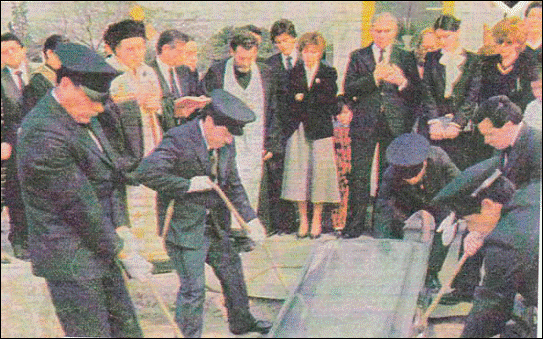|
|
PapalTiara. The Triregnum or Papal Tiara symbolizes the
spiritual and temporal power of Papism over the Church and over all the
nations of the world. It is worn only by popes during non-liturgical
services, such as ceremonial processions, ceremonial coronation etc.. Furnished with three diadems, it is ornamented with precious stones and
pearls and has at its highest point a cross resting on a globe. This three tiered crown (Triregnum),
was worn by popes from Clement V (1305-1314) up to and including PaulVI who was crowned in 1963. Though not worn by any
of Pope Paul’s successors, it has not been abolished and therefore remains the
symbol of the papacy and the Holy See, featured in the |
|
The Coronation of
Pope PaulVI (1963-1978). During the ceremonial coronation the
archdeacon placed the Tiara on the head of the new pope and recited this
prayer: Accept
the Tiara ornamented with three diadems and know that you are the Father of Princes
and Kings, Despot of the entire world, earthly representative of our Savior Jesus Christ, to whom belongs honor and glory unto the
ages of ages. Αccipe tiaram tribus coronis ornatam, et scias te esse
Patrem Principum et
Regnum, Rectorem Orbis,
in terra Vicarium Salvatoris
Nostri Jesu Christi, cui est honor et gloria in s.cula s.culorum. |
|
|
|
After Paul VI the ceremonial coronation was
substituted (and not abolished) by the ceremonial Inauguration of the Supreme Pontificate |
|
Pope Benedict
XVI. The refusal of the
last three popes to wear the Tiara in no way alters papal ambitions and cacodoxies. The main dogmas of the primacy and infallibility
of the pope responsible for all visible and symbolic deviations of Papism remain
firmly entrenched. According to Cardinal
Bea (Harvard Colloquium), “it would be simply
dishonest to suggest that there is any likelihood that the dogmas of the primacy
of the infallibility of the pope will be revised” (Robert B. Keiser,The story ofVatican pp. 254-255). Of course not!These
two dogmas are the two pillars upon which the entire papal edifice rests;
their abolishment would automatically bring about the collapse of Papism. |
|
|
|
The Insignia of Papism. Though not currently worn as part of the papal regalia,
the Papal Tiara is used on the flag and coats of arms of the Holy See and the
|
|
The first bishop of Kenge,
Since then this custom was also suspended (for a time). We are deeply grateful to his Eminence Bishop
Chrysostom of Rodostolon, who provided this most
rare photograph. It could possibly be the only such photograph available in
circulation today. |
|
|
|
Until the first half of the 20th
century, it was customary for pilgrims
having an audience with the pope to kiss the cross on his red slipper, after
having made three prostrations as a sign of total obedience and reverence. |
|
The Portable Throne (Sedia
Gestatoria) The Sedia Gestatoria is a portable throne on which the popes were carried
until 1978. It consists of a richly adorned, silk-covered armchair, fastened to a suppedaneum, on either side of which are two gilded rings through which long rods are passed.Twelve
palafrenieri (footmen)
in red uniforms use the long rods to carry the throne on their shoulders. Two
large fans (flabella) made of white ostrich feathers are carried at either
side of the Sedia Gestatoria.
After its last use by Pope Paul I in 1978, the Sedia Gestatoria was replaced by the pope mobile. The pope ex cathedra with the two large ostrich feather fans (flabella). |
|
|
Paul de Ballester’s parents,Francisco
and Maria. |
|
|
Father Paul as an archimandrite. |
|
|
His Grace Paul, Bishop of Nazianzus. |
|
|
The |
|
|
The casket with the
remains of Bishop Paul is lowered into the tomb. |
|
|
The portrait of Fr.
Paul De Ballester permanently adorns the focal wall
of the priest's office of the Greek Orthodox Church of the Annunciation in |
|

















